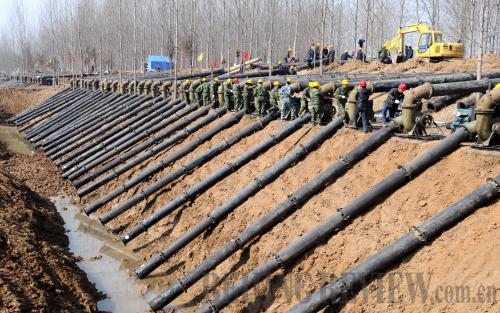|
 |
|
PUMPS APLENTY: Workers install water pumps on the south bank of Luoma Lake in Jiangsu Province. China unveiled a series of anti-drought measures to boost grain production across the country (BAI ZHIYONG) |
Ding said there are six points of concern for Chinese food security that need attention.
First, some local governments do not put enough stress on food security. Although the Central Government has set national food security as an important strategic task, some local governments are still advancing industrialization, commercialization and urbanization at the price of sacrificing agriculture and grain production.
Second, grain consumption will soon surpass available supplies. With population growth, improved food structure, as well as development of modern food industries and expansion of the feedstuff industry, the country's total grain demand will show rigid growth, Ding said. It's estimated that by 2020 China's total grain demand will top 600 million tons, which will surpass the country's total grain supply at the same time.
Third, grain production is more restricted by agricultural resources, such as reducing per-capita cultivated land and water resources, deteriorating land quality, and environment pollution for grain production. MOA figures show at present the per-capita cultivated land in China is less than 953 square meters and per-capita water resource is about 2,070 cubic meters, both much lower than the world average level.
Fourth, the resource allocation and structure for grain production are increasingly unbalanced. South China used to be the main wheat- and rice-growing region, but has now become a major grain consumer. North China, which lacks water resources, now contributes more to the grain output, but faces more serious shortages in water resources for irrigation.
Fifth, China lacks a quality industrial force for modern grain production. Chinese agricultural production now mainly depends on small-scale family operations. Women and the elderly now constitute the main labor force in rural areas that lack young, strong hands and talent well versed in science and technology.
"For a country that relies so heavily on grain, it's worrisome that there lacks a quality contingent of agricultural workers in rural areas," Ding said.
Sixth, foreign grain merchants look to nibble away at China's food industry. The weak U.S. dollar has further driven up international grain prices denominated in dollars, stimulating and driving international speculative capital to flow into bulk farm produce markets. Now the four biggest transnational grain merchants—Archer Daniels Midland Co., Bunge Ltd., Cargill, Incorporated and Louis Dreyfus SAS—monopolize 80 percent of the world's grain transactions and control absolute grain-pricing power. China has almost no say in the international grain market.
"There are lurking risks or hidden troubles for China's sustainable food security, so we must be careful to cope with it," Ding said.
The 10 Measures to Boost Grain Production
- Enlarge the subsidy scope for winter wheat irrigation, keeping the subsidy standard at 150 yuan ($22.8) per hectare.
- Grant joint subsidies for winter wheat of 150 yuan ($22.8) per hectare.
- The central budget arranges 1.2 billion yuan ($182.37 million) in subsidies to purchase irrigation machinery in main winter wheat-growing areas.
- Grant subsidies for pest control to 800 counties in main grain-growing regions of wheat, rice and corn, as well as 200 counties in pest origin areas, and give financial support worth 250,000 yuan ($38,000) each to 2,000 large-scale professional service organizations.
- The central budget arranges 500 million yuan ($75.99 million) to construct 200,000 rice seedling hothouses in northeast China.
- Grant subsidies worth 150 yuan ($22.8) per hectare for film planting of corn in southwest China, covering an area of 3.33 million hectares.
- Expand the scope of subsidies for county-level anti-drought service teams. Provide subsidies for anti-drought equipment for an extra 200 counties, or 2 million yuan ($303,951) per county.
- Strengthen infrastructure construction against drought. The government will spend at least 6.7 billion yuan ($1.02 billion) to divert water to affected areas and construct emergency wells and other irrigation facilities.
- Increase the minimum purchasing prices of wheat and rice. The purchasing prices for early and middle-late indica rice as well as japonica rice produced in 2011 will rise 9 yuan ($1.37), 10 yuan ($1.52) and 23 yuan ($3.5), respectively, to 102 yuan ($15.5), 107 yuan ($16.26) and 128 yuan ($19.45) per 50 kg.
- Launch a national campaign to increase grain production, improve rewarding policies for major grain-producing counties, increase the amount of rewarding capital and intensify the effort to increase grain output. | 